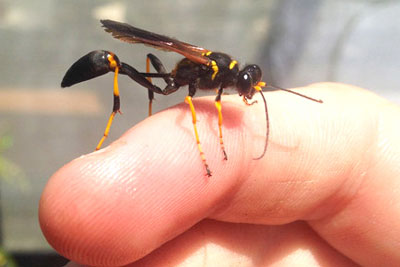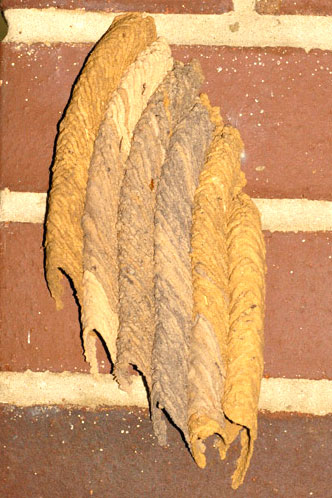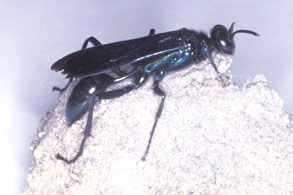Mud Daubers Are Really Your Friends
I was answering a question for one of my newspaper columns recently, and the topic was mud daubers. The reader wanted to know how to kill them.
I asked if they were really sure that they wanted to hurt them. After all, not all insects that sting are our enemies. (Can you say “honeybees?”)
It turns out that mud daubers are pretty good buddies to keep hanging around. Oh, sure, they make a mess on the side of the house where they build their mud tunnels. But consider what they do inside those mud tubes.

Black and yellow mud daubers
These are the most common types, at least at our place. They’re about an inch long, and they glide around on patrol. Until I did my research for this I thought they were just looking for mud from which they could daub globs to make their round nests on the walls and along the eaves of our house.

Pipe organ mud daubers
If ever there were an appropriate name! These tubes are long, flat, and parallel like the ranks of pipes in a church organ.
Both of these species take paralyzed spiders back to their tubes (nests) and leave them there for their larvae to use as food sources as the eggs hatch and develop.

Blue mud daubers
These are a slight bit smaller, and they’re iridescent. They move into and take over the nests of the pipe organ mud daubers, and they bring primarily black widow spiders to serve as their larval food source.
Now, I want to tell you that we have quite a few of these blue mud daubers. They frequently end up inside our house. I’ve not seen a black widow inside or outside our house in the 46 years that we’ve been here, but maybe now I know why. This spider has gained a whole lot of new respect from me. For sure, I’ll keep catching them with my drinking glass-and-paper technique and releasing them back into nature.
So, no spraying of mud daubers for Neil. I’m content to live and let live. I’ll catch and release where appropriate, and I’ll continue to teach my kids, now my grandkids and great-granddaughter Jackie to respect the wildlife of nature.
We can all get along, can’t we!
Note: Special thanks to the entomologists, Erin Powell, Lyle Buss and JL Castner, of the University of Florida for the three photos I’ve borrowed for this story. I could not have done it without you. Here is a link to their entire post.
